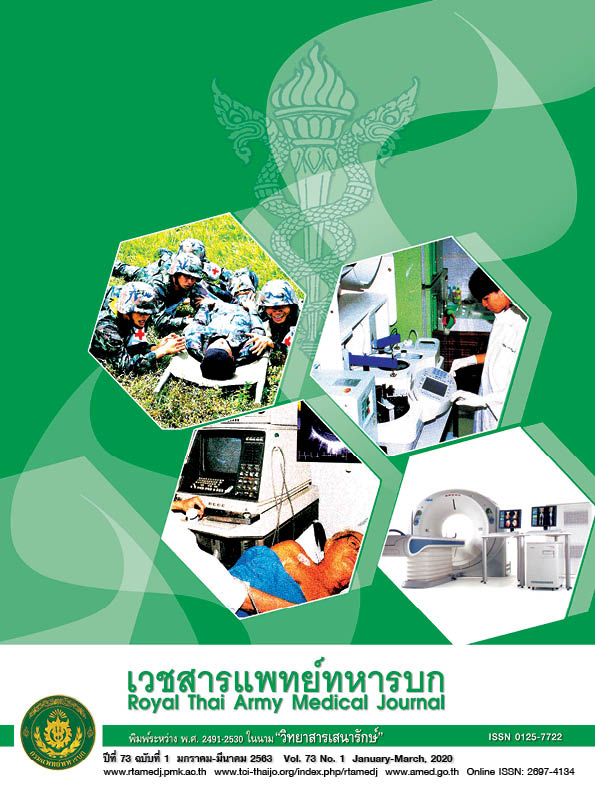การศึกษาเปรียบเทียบการสูญเสียการได้ยินด้วยเครื่องตรวจ 3 ชนิด ในทหารเกณฑ์หลังยิงปืน
Main Article Content
บทคัดย่อ
บทนำ ทหารเกณฑ์ใหม่ตอ้ งได้รับการฝึกยิงปืนซึ่งหากเกิดการสูญเสียการได้ยินจะมีผลต่อคุณภาพชีวิตในอนาคต โดยทัว่ ไปใชเ้ครื่องตรวจการได้ยินแบบไฟฟ้าชนิดมาตรฐาน (conventional audiometry) แต่มีขอ้ จำกัด คือ ขาดความไวในการวินิจฉัยความถี่ที่สูงกว่า 8,000 เฮิรตซ์ และขาดความไวในการตรวจพบความผิดปกติในระยะเริ่มตน้ งานวิจัยนี้จึงมีวัตถุประสงค์ที่จะเปรียบเทียบการสูญเสียการได้ยินในทหารเกณฑ์ที่เขา้ รับการฝึกยิงปืน M16 ระหว่าง Conventional audiometry เครื่องตรวจการได้ยินแบบไฟฟ้าชนิดความถี่สูง (Extended High-frequency-EHF audiometry) และเครื่องตรวจวัดเสียงสะทอ้ นจากเซลล์ขนหูชั้นในด้านนอก (otoacoustic emissions-OAEs) เพื่อใหส้ ามารถตรวจวินิจฉัยการเปลี่ยนแปลงในระยะเริ่มตน้ ได้ครอบคลุมมากขึ้น วัสดุและวิธีการ เป็นการศึกษาแบบ prospective descriptive study โดยมีทหารเกณฑ์จำนวน 80 คนได้รับการซักประวัติ กรอกแบบสอบถาม ตรวจหูและวัดระดับการได้ยินด้วยเครื่องตรวจทั้ง 3 ชนิด ช่วงก่อน หลังยิงปืนภายใน 24 ชัว่ โมงและหลังยิงปืน 48 ชัว่ โมง โดยทำการฝึกยิงคนละ50 นัด ผลการวิจัย ทหารเกณฑ์ 80 คน อายุเฉลี่ย 20.65 ปี การได้ยินปกติก่อนยิงปืนทุกคน หลังยิงปืนภายใน 24 ชัว่ โมง เมื่อตรวจด้วย EHF audiometry และ OAEs พบความผิดปกติเพิ่มขึ้นร้อยละ 20 และ ร้อยละ 18.7 และหลังยิงปืน 48 ชัว่ โมงตรวจพบการได้ยินผิดปกติร้อยละ 33.7 และร้อยละ 28.7 ตามลำดับ สรุป EHF audiometry และ OAEs ช่วยสืบค้นการสูญเสียการได้ยินเพิ่มเติมจาก conventional audiometry ได้
Downloads
Article Details
บทความในวารสารนี้อยู่ภายใต้ลิขสิทธิ์ของ กรมแพทย์ทหารบก และเผยแพร่ภายใต้สัญญาอนุญาต Creative Commons Attribution-NonCommercial-NoDerivatives 4.0 International (CC BY-NC-ND 4.0)
ท่านสามารถอ่านและใช้งานเพื่อวัตถุประสงค์ทางการศึกษา และทางวิชาการ เช่น การสอน การวิจัย หรือการอ้างอิง โดยต้องให้เครดิตอย่างเหมาะสมแก่ผู้เขียนและวารสาร
ห้ามใช้หรือแก้ไขบทความโดยไม่ได้รับอนุญาต
ข้อความที่ปรากฏในบทความเป็นความคิดเห็นของผู้เขียนเท่านั้น
ผู้เขียนเป็นผู้รับผิดชอบต่อเนื้อหาและความถูกต้องของบทความของตนอย่างเต็มที่
การนำบทความไปเผยแพร่ซ้ำในรูปแบบสาธารณะอื่นใด ต้องได้รับอนุญาตจากวารสาร
เอกสารอ้างอิง
2. Yong JS, Wang DY. Impact of noise on hearing in the military. Mil Med Res. 2015;2:6.
3. Brown CJ. Electrophysiologic Assessment of Hearing. In: Flint P, Cummings C, Haughey B, Thomas R, Harker L, Robbins T, et al, eds. In:Cummings Otolaryngology: Head and Neck Surgery Review. 4th ed. Baltimore: Mosby; 2005. P. 3466-76.
4. Dobie RA. Noise-induced hearing loss. In: Bailey BJ, Johnson JT, Newlands SD, eds. Head and Neck Surgery-Otolaryngology. 4th ed. Vol. 2. Philadelphia, USA: Lippincott Williams & Wilkins;2006. P. 2906-23.
5. Arts HA. Sensorineural hearing loss: evaluation and management in adults. In: Cummings Otolaryngology :Head and Neck. 4th ed. Vol. 3. Philadelphia, USA: Lippincott Williams & Wilkins;2006. P. 3542-3.
6. Le Prell CG, Yamashita D, Minami SB, Yamasoba T, Miller JM. Mechanisms of noise-induced hearing loss indicate multiple methods of prevention. Hear Res. 2007;226(1-2):22-43.
7. Stanley A. Essentials of Audiology. 4th ed. New York, NY: Thieme;2016. P. 456- 497.
8. Helfer TM, Jordan NN, Lee RB. Postdeployment hearing loss in U.S. Army soldiers seen at audiology clinics from April 1, 2003, through March 31, 2004. Am J Audiol. 2005;14(2):161-8.
9. Hausler R. The effects of acoustic overstimulation. Ther Umsch. 2004;61(1):21-
10. HOTZ MA, PROBST R, HARRIS FP, HAUSER R. Monitoring the Effects of Noise Exposure using Transiently Evoked Otoacoustic Emissions. Acta Otolaryngol (Stockh). 1993;113(4):478-482.
11. Marshall L, Lapsley Miller JA, Heller LM, Wolgemuth KS, Hughes LM, Smith SD, et al. Detecting incipient inner-ear damage from impulse noise with otoacoustic emission. J A coust Soc Am. 2009;125(2):995-1013.
12. Mehrparvar AH, Mirmohammadi SJ, Davari MH, Mostaghaci M, Mollasadeghi A, Bahaloo M, et al. Conventional Audiometry, High-Frequency Audiometry, and DPOAE for Early Diagnosis of NIHL. Iran Red Cres Med J. 2014;16(1):140-147.
13. Balatsouras DG, Homsioglou E, Danielidis V. Extended high-frequency audiometry in patients with acoustic trauma. Clin. Otolaryngol. 2005;30(3):249–254.
14. Flint PW, Haughey BH, Lund VJ, Niparko J, Robbins K, Thomas JR, et al. Cummings Otolaryngology Head & Neck surgery. 6th ed. Philadelphia, USA: Mosby Elsevier;2015. P. 2345-2355.
15. Humes LE, Joellenbeck LM, Durch JS. Responding to Noise Risks: Hearing Conservation Programs in the Military. In: Noise and military service. Implication for hearing loss and tinnitus. Washington, DC: The National Academies Press;2006; P.146-189.
16. Rocha RL, Atherino CC, Frota SM. High-frequency audiometry in normal hearing military firemen exposed to noise. Braz J Otorhinolaryngol. 2010;76(6):687-94.
17. Bourchom W., Hanchumpol P., Jaruchinda P. Comparative Study of Hearing Loss Between Using and Non-using 5-Wings type Ear Protection of Thai Military Training. J Med Assoc Thai. 2018;101(7):971-5.


